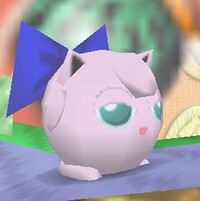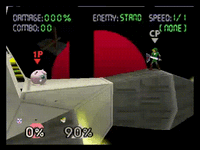Jigglypuff (SSB)/Down special
Overview
Jigglypuff falls asleep for a few seconds before waking up (known as Rest). On the first frame and only the first frame of the move, there is a hitbox surrounding Jigglypuff, which deals high damage and extreme knockback (KOing Mario at around 47% at the center of Dream Land). This makes it one of the most powerful moves in the game and due to its instant startup, it can be comboed into with a variety of moves, such as a forward throw, up tilt, up aerial or down aerial. Jigglypuff can also use teleporting (as well as momentum sliding in the Japanese version) to approach with Rest.
With all its power and ability to make any player think twice about some things, Rest has by far the most ending lag of any move in the game, leaving Jigglypuff utterly vulnerable and helpless for 220 frames (about 3.7 seconds). If the move doesn't hit the opponent during its single frame of damage, virtually any opponent will be able to set up any punish such as with a smash attack, any combo starter or another powerful move that is otherwise too slow to connect. The move's extreme lag also makes it a guaranteed self-destruct if used with no ground below and no teammates are around to hit Jigglypuff; as a result, successfully connecting with a midair Rest is considered flashy, especially if it ends a match.
Rest includes 29 frames of intangibility at the start of the move. However, it is never worth using the move for the purpose of dodging an attack due to its extreme ending lag, which leaves Jigglypuff in a much more vulnerable position.
The move was much weaker in the Japanese version as it only dealt 14% damage and had much lower knockback. It could not KO Mario at the center of Dream Land until 88%; making it even weaker than Kirby's forward smash. The move was also nerfed in the PAL versions of the game as its hitbox was made smaller. This means that in order to land Rest, Jigglypuff has to be completely inside its opponent; which overall makes Rest harder to land.
Hitboxes
NTSC-J
| ID | Part | Damage | SD | Angle | BK | KS | FKV | Radius | Bone | Offset | Clang | Effect | G | A | Sound | ||
|---|---|---|---|---|---|---|---|---|---|---|---|---|---|---|---|---|---|
| 0 | 0 | 14% | 0 | 20 | 140 | 0 | 130 | 0 | 0 | 150 | 0 | ||||||
NTSC-U
| ID | Part | Damage | SD | Angle | BK | KS | FKV | Radius | Bone | Offset | Clang | Effect | G | A | Sound | ||
|---|---|---|---|---|---|---|---|---|---|---|---|---|---|---|---|---|---|
| 0 | 0 | 20% | 0 | 60 | 120 | 0 | 130 | 0 | 0 | 150 | 0 | ||||||
PAL
| ID | Part | Damage | SD | Angle | BK | KS | FKV | Radius | Bone | Offset | Clang | Effect | G | A | Sound | ||
|---|---|---|---|---|---|---|---|---|---|---|---|---|---|---|---|---|---|
| 0 | 0 | 20% | 0 | 60 | 120 | 0 | 60 | 0 | 0 | 150 | 0 | ||||||
Summary
NTSC-J to NTSC-U
 Damage (14% → 20%).
Damage (14% → 20%). Knockback (20 (base), 140 (scaling) → 60/120).
Knockback (20 (base), 140 (scaling) → 60/120). Hit sfx changed from a heavy kick to a heavy bat.
Hit sfx changed from a heavy kick to a heavy bat.
NTSC-U to PAL
 Hitbox size (130u → 60u).
Hitbox size (130u → 60u).
Timing
| Hitbox | 1 |
|---|---|
| Intangible | 1-29 |
| Animation length | 249 |
Lag time |
Hitbox |
Vulnerable |
Intangible |

